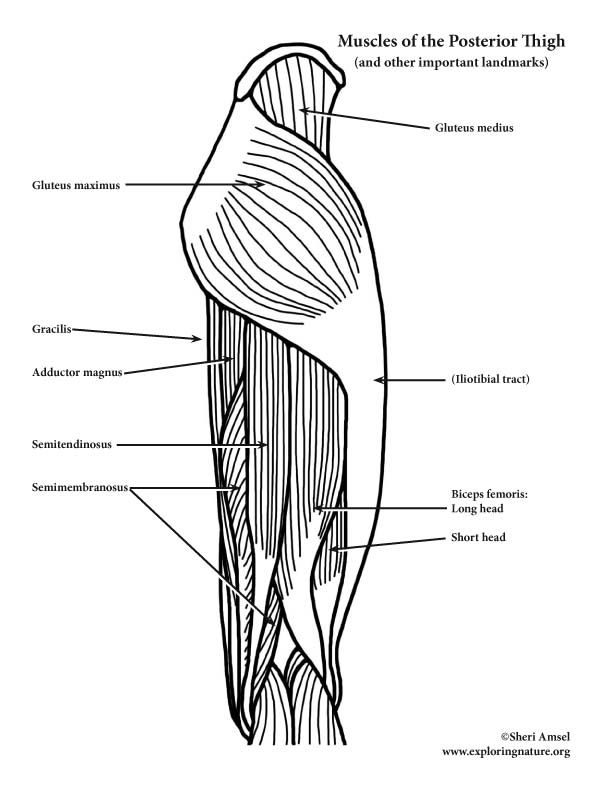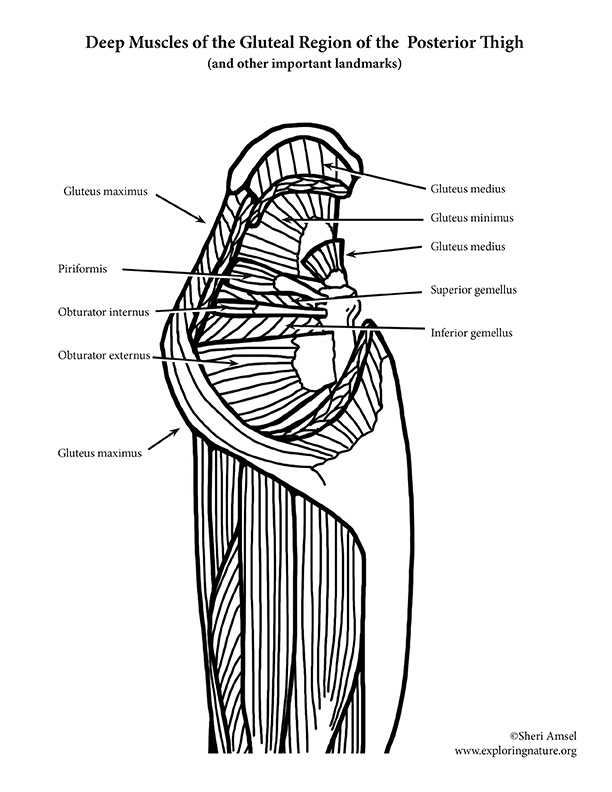

Muscles Crossing Hip and Knee Joints
Muscles of the Posterior Compartment of Pelvis
1) Gluteus maximus
a. Actions: extends thigh (at hip) for climbing stairs and running, laterally rotates thigh
(opposite action of the iliopsoas muscle).
b. Innervation: Inferior gluteal nerve
c. Origin: from ilium and dorsal sacrum
d. Insertion: to gluteal tuberosity of femur and iliotibial tract
2) Gluteus medius
a. Actions: abducts and medially rotates thigh for walking, holds up pelvis when waling so it doesn’t tip down and foot can swing free
of the ground
b. Innervation: Superior gluteal nerve
c. Origin: from ilium
d. Insertion: to greater trochanter of femur
3) Gluteus minimus
a. Actions: aids Gluteus medius in actions
b. Innervation: Superior gluteal nerve
c. Origin: from ilium
d. Insertion: to greater trochanter of femur
Lateral Rotators of Thigh (Posterior)
4) Piriformis
a. Actions: lateral rotator of thigh, aids in abduction of thigh when hip is flexed
b. Innervation: S1, S2, L5
c. Origin: from anterior sacrum
d. Insertion: to greater trochanter of femur
5) Obturator externus
a. Actions: lateral rotator of thigh, stabilizes hip joint
b. Innervation: Obturator nerve
c. Origin: from margin of obturator foramen on pubis and ischium
d. Insertion: to posterior femur between greater and lesser trochanter of femur
6) Obturator internus
a. Actions: lateral rotator of thigh, stabilizes hip joint
b. Innervation: L5 – S1
c. Origin: from obturator membrane and greater sciatic notch
d. Insertion: to greater trochanter of femur
7) Gemellus (Superior and Inferior)
a. Actions: lateral rotator of thigh, stabilizes hip joint
b. Innervation: L4, L5, S1
c. Origin: from ischial tuberosity
d. Insertion: to greater trochanter of femur
8) Quadratus femoris
a. Actions: lateral rotator of thigh, stabilizes hip joint
b. Innervation: L4, L5, S1
c. Origin: from ischial tuberosity
d. Insertion: to greater trochanter of femur
Muscles of the Posterior Compartment of Thigh (Knee Flexors and Thigh Extensors)
Hamstrings – three-muscle complex
9) Biceps femoris
a. Actions: extends thigh at hip, flexes knee, laterally rotates leg
b. Innervation: Sciatic nerve
c. Origin: long head from ischial tuberosity, short head from linea aspera
d. Insertion: to lateral leg to fibula head and lateral condyle of tibia
10) Semitendinosus
a. Actions: extends thigh at hip, flexes knee, medially rotates leg
b. Innervation: Sciatic nerve
c. Origin: from ischial tuberosity
d. Insertion: to medial tibial shaft
11) Semimembranosus
a. Actions: extends thigh at hip, flexes knee, medially rotates leg
b. Innervation: Sciatic nerve
c. Origin: from ischial tuberosity
d. Insertion: to medial condyle of tibia
_____________________________________________________________________________________________________________________________________
Use this study tool to learn the Muscles of the Posterior Hip and Thigh: Color the Muscles of the Thigh (Posterior)
Assess your knowlege of the Muscles of the Posterior Hip and Thigh: Label the Muscles of the Thigh (Posterior)
_______________________________________________________________________________________________________

